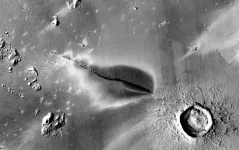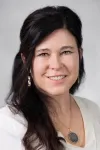(Press-News.org) Evidence of recent volcanic activity on Mars shows that eruptions could have taken place in the past 50,000 years, according to new study by researchers at the University of Arizona's Lunar and Planetary Laboratory and the Planetary Science Institute.
Most volcanism on the Red Planet occurred between 3 and 4 billion years ago, with smaller eruptions in isolated locations continuing perhaps as recently as 3 million years ago. But, until now, there was no evidence to indicate Mars could still be volcanically active.
Using data from satellites orbiting Mars, researchers discovered a previously unknown volcanic deposit. They detail their findings in the paper "Evidence for geologically recent explosive volcanism in Elysium Planitia, Mars," published in the journal Icarus.
"This may be the youngest volcanic deposit yet documented on Mars," said lead study author David Horvath, who did the research as a postdoctoral researcher at UArizona and is now a research scientist at the Planetary Science Institute. "If we were to compress Mars' geologic history into a single day, this would have occurred in the very last second."
The volcanic eruption produced an 8-mile-wide, smooth, dark deposit surrounding a 20-mile-long volcanic fissure.
"When we first noticed this deposit, we knew it was something special," said study co-author Jeff Andrews-Hanna, an associate professor at the UArizona Lunar and Planetary Laboratory and the senior author on the study. "The deposit was unlike anything else found in the region, or indeed on all of Mars, and more closely resembled features created by older volcanic eruptions on the Moon and Mercury."
Further investigation showed that the properties, composition and distribution of material match what would be expected for a pyroclastic eruption - an explosive eruption of magma driven by expanding gasses, not unlike the opening of a shaken can of soda.
The majority of volcanism in the Elysium Planitia region and elsewhere on Mars consists of lava flowing across the surface, similar to recent eruptions in Iceland being studied by co-author Christopher Hamilton, a UArizona associate professor of lunar and planetary sciences. Although there are numerous examples of explosive volcanism on Mars, they occurred long ago. However, this deposit appears to be different.
"This feature overlies the surrounding lava flows and appears to be a relatively fresh and thin deposit of ash and rock, representing a different style of eruption than previously identified pyroclastic features," Horvath said. "This eruption could have spewed ash as high as 6 miles into Mars' atmosphere. It is possible that these sorts of deposits were more common but have been eroded or buried."
The site of the recent eruption is about 1,000 miles (1,600 kilometers) from NASA's InSight lander, which has been studying seismic activity on Mars since 2018. Two Marsquakes, the Martian equivalent of earthquakes, were found to originate in the region around the Cerberus Fossae, and recent work has suggested the possibility that these could be due to the movement of magma deep underground.
"The young age of this deposit absolutely raises the possibility that there could still be volcanic activity on Mars, and it is intriguing that recent Marsquakes detected by the InSight mission are sourced from the Cerberus Fossae," Horvath said. In fact, the team of researchers predicted this to be a likely location for Marsquakes several months before NASA's InSight lander touched down on Mars.
A volcanic deposit such as this one also raises the possibility for habitable conditions below the surface of Mars in recent history, Horvath said.
"The interaction of ascending magma and the icy substrate of this region could have provided favorable conditions for microbial life fairly recently and raises the possibility of extant life in this region," he said.
Similar volcanic fissures in this region were the source of enormous floods, perhaps as recently as 20 million years ago, as groundwater erupted out onto the surface.
Andrews-Hanna's research group continues to investigate the causes of the eruption. Pranabendu Moitra, a research scientist in the UArizona Department of Geosciences, has been probing the mechanism behind the eruption.
An expert in similar explosive eruptions on Earth, Moitra developed models to look at the possible cause of the Martian eruption. In a forthcoming paper in the journal Earth and Planetary Science Letters, he suggests that the explosion either could have been a result of gases already present in the Martian magma, or it could have happened when the magma came into contact with Martian permafrost.
"The ice melts to water, mixes with the magma and vaporizes, forcing a violent explosion of the mixture," Moitra said. "When water mixes with magma, it's like pouring gasoline on a fire."
He also points out that the youngest volcanic eruption on Mars happened only 6 miles (10 kilometers) from the youngest large-impact crater on the planet - a 6-mile-wide crater named Zunil.
"The ages of the eruption and the impact are indistinguishable, which raises the possibility, however speculative, that the impact actually triggered the volcanic eruption," Moitra said.
Several studies have found evidence that large quakes on Earth can cause magma stored beneath the surface to erupt. The impact that formed the Zunil crater on Mars would have shaken the Red Planet just like an earthquake, Moitra explained.
While the more dramatic giant volcanoes elsewhere on Mars - such as Olympus Mons, the tallest mountain in the solar system - tell a story of the planet's ancient dynamics, the current hotspot of Martian activity seems to be in the relatively featureless plains of the planet's Elysium region.
Andrews-Hanna said it's remarkable that one region hosts the epicenters of present-day earthquakes, the most recent floods of water, the most recent lava flows, and now an even more recent explosive volcanic eruption.
"This may be the most recent volcanic eruption on Mars," he said, "but I think we can rest assured that it won't be the last."
The volcanic deposit described in this study, along with ongoing seismic rumbling in the planet's interior detected by InSight and possible evidence for releases of methane plumes into the atmosphere detected by NASA's MAVEN orbiter, suggest that Mars is far from a cold, inactive world, Andrews-Hanna said.
"All these data seem to be telling the same story," he said. "Mars isn't dead."
INFORMATION:
All three species of manatee now present on Earth share a common ancestor from which they split some 6.5 million years ago, when a huge lake in Amazonia, then linked to the Caribbean, was cut off from the sea. The African manatee Trichechus senegalensis is not as genetically close to the West Indian manatee T. manatus as was thought, and adaptation to this complex environment by the Amazonian manatee T. inunguis has left at least one mark in its genetic code.
These are key findings of a study supported by FAPESP and published in Scientific Reports, with hitherto unknown details of the evolutionary history of these aquatic mammals. The authors are an international group of scientists led by researchers at the University of Campinas ...
The American College of Chest Physicians® (CHEST) recently released new clinical guidelines on the Diagnosis and Evaluation of Hypersensitivity Pneumonitis (HP). The guidelines contain 14 evidence-based recommendations to improve individual diagnostic decision-making and to decrease diagnostic practice variability.
Occurring at any age, HP is an immunologically mediated form of lung disease resulting from inhalational exposure to a large variety of environmental and/or occupational inciting antigens (typically fungal, bacterial, avian). Over the years, the categorization of HP based on clinical features and disease duration coupled with traditional diagnostic criteria has been unhelpful, even when accurate, when separated from a probabilistic diagnostic ...
Clavelina oblonga, an invasive marine fouling species, not only reduces diversity in communities it invades, it also interferes in their recovery following natural disasters - a process known as "succession."
Succession refers to how an ecosystem recovers after a disturbance or natural disaster - does the system come back more or less the same as it was in terms of species composition, or is it different?
"The classic example of succession is a forest that experiences a wildfire," says Kayla Christianson, former NC State graduate student and first author of a paper describing the research. "As the community recovers from the fire, it proceeds through a predictable pattern of community development - starting with grasses and ending with trees and a mature forest. This ...
Since it debuted in 2011, the Get SET Early program, which provides pediatricians and parents with a relatively simple process to screen for indicators of autism spectrum disorder (ASD) in children as young as age 1, has steadily grown in use and validation. Early screening and identification of ASD has been linked to more effective treatment.
A new study, published in the April 26, 2021 issue of the END ...
PHILADELPHIA-- Human brain organoids are remarkable platforms for modeling features of human brain development and diseases. Building on methods to generate organoids to model different brain regions such as the cortex and the midbrain, researchers at the Perelman School of Medicine at the University of Pennsylvania have generated the first organoids of the arcuate nucleus (ARC), an essential structure in the hypothalamus that sends signals of hunger and feeling full. This part of the hypothalamus exhibits a tremendous amount of cell diversity, and is far more complex than previously modeled parts of the brain.
In a paper ...
Scientists have made major advances in understanding and developing treatments for many cancers by identifying genetic mutations that drive the disease. Now a team led by researchers at Weill Cornell Medicine, NewYork-Presbyterian and the New York Genome Center (NYGC) has developed a machine learning technique for detecting other modifications to DNA that have a similar effect.
The study, published May 10 in Cancer Discovery, a journal of the American Association for Cancer Research, focuses on a type of chemical modification to DNA, called methylation, that typically silences nearby genes. The new technique can analyze the thousands of DNA methylation changes detected in tumor cells and infer which ones are likely ...
HOUSTON - Researchers at The University of Texas MD Anderson Cancer Center have developed a first-of-its-kind spatial atlas of early-stage lung cancer and surrounding normal lung tissue at single-cell resolution, providing a valuable resource for studying tumor development and identifying new therapeutic targets. The study was published today in Cancer Discovery, a journal of the American Association for Cancer Research.
The findings reveal a heterogeneous lung cancer ecosystem, with extensive interactions between cancer cells and the surrounding microenvironment that regulate early cancer development. ...
New research on the growth rates of coral reefs shows there is still a window of opportunity to save the world's coral reefs--but time is running out.
The international study was initiated at the ARC Centre of Excellence for Coral Reef Studies (Coral CoE), which is headquartered at James Cook University (JCU).
Co-author Professor Morgan Pratchett from Coral CoE at JCU said the results show that unless carbon dioxide emissions are drastically reduced the growth of coral reefs will be stunted.
"The threat posed by climate change to coral reefs is already very apparent based on recurrent episodes of mass coral bleaching," Prof Pratchett said. "But changing environmental conditions will have other far-reaching consequences."
Co-author Professor Ryan Lowe, from Coral CoE at The University ...
A new study looking at the evolutionary history of the human oral microbiome shows that Neanderthals and ancient humans adapted to eating starch-rich foods as far back as 100,000 years ago, which is much earlier than previously thought.
The findings suggest such foods became important in the human diet well before the introduction of farming and even before the evolution of modern humans. And while these early humans probably didn't realize it, the benefits of bringing the foods into their diet likely helped pave the way for the expansion of the human brain because of the glucose in starch, which is the brain's main fuel source.
"We think we're seeing evidence of a really ...
ORLANDO, May 10, 2021 -University of Central Florida researchers are building on their technology that could pave the way for hypersonic flight, such as travel from New York to Los Angeles in under 30 minutes.
In their latest research published in the journal Proceedings of the National Academy of Sciences, the researchers discovered a way to stabilize the detonation needed for hypersonic propulsion by creating a special hypersonic reaction chamber for jet engines.
"There is an intensifying international effort to develop robust propulsion systems for hypersonic and supersonic flight that would allow flight through our atmosphere at very high speeds and also allow efficient entry and exit from planetary atmospheres," ...





